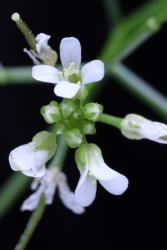- ≡ Cardamine flexuosa var. occulta (Hornem.) O.E.Schulz, Bot. Jahrb. Syst. 32: 479 (1903)
Annual herb, few to many lateral branches or occasionally a single stem; stems usually sparsely to moderately hairy, especially on lower half; sometimes rooting at nodes. Leaves up to 77 mm long, pinnatisect, rosette and lower cauline leaves withering; lamina 25.0–70.0 × 8.0–43.0 mm, green, membranous, glabrous to sparsely hairy on abaxial and adaxial surfaces, margin and petiole; hairs 0.2–0.4 mm long, spreading to patent; petiole up to 15 mm long. Terminal pinna 4.0–32.0 × 4.0–19.0 mm, simple, elliptic, broadly elliptic, orbicular, often palmatifid, margins entire or shallowly 1–4-lobed, often asymmetric and irregular, lobes with distinct hydathodes, apex subacute to obtuse, usually with a distinct hydathode, base attenuate, cuneate or obtuse, often oblique. Lateral pinnae 4–8, 4.5–24.0 × 1.0–8.0 mm, elliptic to broadly elliptic, margin entire or occasionally shallowly 1–2-lobed, apex subacute, obtuse or truncate, base attenuate, cuneate or obtuse, often oblique, petiolule 1.0–3.0 mm long. Cauline leaves similar to rosette leaves but with narrower terminal and lateral pinnae, linear to narrowly elliptic, pinnae bases attenuate to cuneate; terminal pinna up to 30.0 × 6.0 mm; lateral pinnae up to 23.0 × 5.0 mm. Inflorescences numerous, racemose, racemes 3–21-flowered; peduncle up to 30 mm long, 0.3–0.8 mm diam. at base, erect to ascending, usually sparsely hairy. Pedicels 2.0–5.0 mm long, 0.2–0.3 mm diam., divaricate to ascending, glabrous. Sepals 1.3–1.7 × 0.4–0.5 mm, elliptic-oblong, slightly saccate, green or red-brown, glabrous, margin white and membranous, apex obtuse, base truncate. Petals 4, 1.8–2.3 × 0.4–0.9 mm, white, limb obovate; apex obtuse; base attenuate, tapering to a 0.4–0.5 mm long claw. Stamens 6; median filaments 4, 1.7–1.8 mm long; lateral filaments 2, 1.1–1.3 mm long; anthers c. 0.2 mm long, cream to pale yellow, when dehiscent held at a similar height to or slightly below the stigma. Ovary 1.8–1.9 mm long, 0.3–0.4 mm diam., ± terete, green, glabrous; ovules 28–32; style c. 0.2 mm long, ± terete; stigma 0.3–0.4 mm diam., white. Siliques 14.0–27.0 × 0.7–1.0 mm, glabrous, style 0.3–0.5 mm long; valves green at maturity and when dehiscent; replum 0.3–0.4 mm wide. Seeds 0.7–0.9 mm long, 0.5–0.6 mm wide, 0.2–0.3 mm thick, broadly oblong, light brown to yellow-brown; wing absent.
South Island: Westland.
Naturalised in New Zealand where it is known from Blue Bottle Creek near Lake Kaniere (Westland, South Island). Also in Australia (Thompson 2003; as C. aff. flexuosa), Europe (Lihova et al. 2006, as Asian C. flexuosa; Bleeker et al. 2008) and North America (Al-Shehbaz et al. 2010; Post et al. 2011); see Marhold et al. (2016) for a detailed account of the distribution of this species. DNA sequence data has shown that Asia (e.g., Japan, China) is the likely origin of naturalised populations in Europe (Lihova et al. 2006). In New Zealand it is possibly more widespread.
Cardamine flexuosa occurs on disturbed stony-gravels adjacent to Blue Bottle Creek. In Japan this species is a serious weed of cultivated areas, preferring wet habitats such as paddy fields, moist gardens, and orchards (Lihova et al. 2006).
The first record is from Blue Bottle Creek, Westland, 16 September 2009, P. B. Heenan s.n., CHR 617206 (Heenan 2017).
Flowering September–February; Fruiting September–February.










